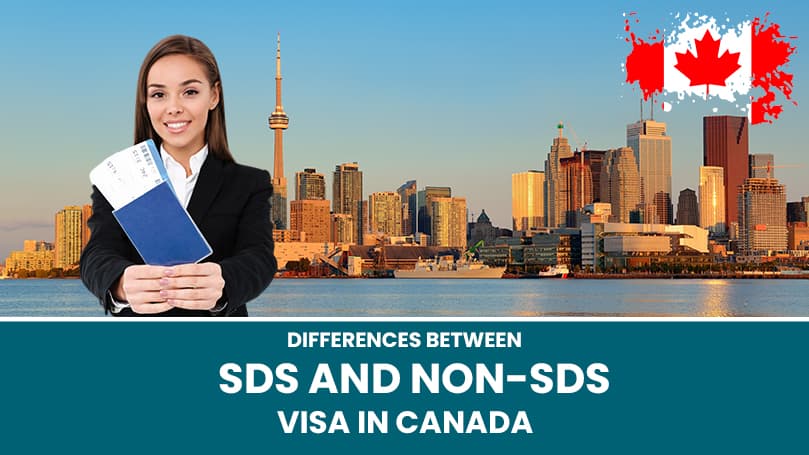If you want to study in Canada, you must be aware of the SDS and non-SDS visa. We all know that obtaining a student visa is important for everyone who wants to study abroad. However, the student visa process is always lengthy and time consuming. Also, it is recommended to apply as soon as you get an offer letter from the university as it usually takes 2-3 months to process for a Canadian student visa.
However, to speed up the student visa process in Canada, the Canadian government has launched a streamlined process called Student Direct Stream (SDS). The main difference between SDS and non-SDS visas is the student visa processing time in Canada.
In this blog, we will discuss the differences and advantages of SDS and non-SDS visas for international students in Canada.
What is an SDS Visa in Canada?
Student Direct Stream (SDS) visa in Canada was launched by Immigration, Refugee and Citizenship Canada (IRCC) to speed up the visa process. The SDS program has fastened the visa process and made it more efficient and convenient. SDS enables applicants to receive their Canadian visas within 4-6 weeks. Also, if an eligible student applies through SDS, the application will most likely be processed within 20 days from the submission date.
What is a Non-SDS Visa in Canada?
The non-SDS visa in Canada is the general visa process for studying, working, and living in Canada. Non-SDS or the general process applies to every country. It’s a time consuming process and has more documentation SDS.
Differences Between SDS and Non-SDS Visa in Canada in 2025
When planning to study in Canada, there are two visa options: SDS and non-SDS. The SDS (Student Direct Stream) visa is a faster choice for students from specific countries. If you’re eligible, this visa is processed quickly, usually within 4-6 weeks, and the application is simpler, taking about 20 days. The non-SDS visa is for students from other countries or those who don’t mind a slower process. It takes longer and usually requires more paperwork. Let’s explore the differences between SDS and non-SDS visas in Canada in 2025.
| Differences | SDS | Non-SDS |
| Visa processing time | 20 days (approx) | 6-8 Weeks approx |
| Eligibility | Acceptable in Antigua and Barbuda, Brazil, China, Colombia, Costa Rica, India, Morocco, Pakistan, Peru, Philippines, Senegal, Saint Vincent and the Grenadines, Trinidad and Tobago, Vietnam | Acceptable in all countries |
| Documentation | Brief | Extensive |
| Process | Efficient and Streamlined | Lengthy and Confusing |
| Medium | Only accepted online | Can be submitted offline |
| Success rate | 71% (approx) | 40% (approx) |
Eligibility Criteria for SDS
Recent updates require you to include a provincial attestation letter (PAL) with your study permit application. The PAL is an important document that confirms your acceptance to a designated learning institution (DLI) in the province or territory where you plan to study. If you don’t include the PAL, your application might be rejected and sent back to you, along with the fees. The eligibility criteria for SDS are given below.
- Obtain a provincial attestation letter from the province or territory you plan to study
- Secure an acceptance letter from a post-secondary designated learning institution
- Must live outside of Canada when applying
- If studying outside Quebec, provide proof of payment for the first year’s tuition
- If studying outside Quebec, provide proof of payment for the first year’s tuition
- Maintain a required amount in a Guaranteed Investment Certificate (GIC) for the intended province or territory of study
- Undergo a medical exam before application, if necessary
- Obtain a police certificate, if necessary
- Provide the most recent secondary or post-secondary school transcripts
- Achieve the minimum required score in one of the qualifying language tests
Eligibility Criteria for Non-SDS
Both SDS and Non-SDS applicants must meet similar requirements. This includes having an acceptance letter, proof of language skills, financial documents, and academic transcripts. The full list of requirements is provided below.
- Official transcripts from Class 12 exams
- Minimum aggregate: 55% for undergraduate programs and 50% or above for postgraduate or advanced diploma courses
- It is crucial to secure an acceptance letter from a Designated Learning Institute (DLI)
- Securing an acceptance letter from a Designated Learning Institute (DLI) is crucial
- Investment of CAD 10,000 in a Guaranteed Investment Certificate for financial security
- Deposit tuition fees to the DLI for six months instead of an entire year
- Write a compelling SOP detailing motivation, educational background, achievements, and study reasons
Documents Required for SDS and non-SDS Visa
Appropriate documentation is a mandatory student visa requirement for Canada. Though the document requirements for SDS and non-SDS visas are similar, some things can be optional for a non-SDS visa application in Canada.
- Valid Passport
- Proof of Acceptance
- Proof of Financial Support
- Proof of scholarship or financial aid (if applicable)
- Medical Examination
- Police Certificate
- Educational Documents
- Academic Results
- Proof of Work Experience
- Application Fee
- Language Test Results
English Language Requirements for SDS and Non-SDS Visa
The minimum English language requirement for SDS and non-SDS visas in Canada is an overall 6.0 IELTS. The minimum PTE requirement for both SDS and non-SDS visas is 60 and the minimum TOEFL requirement is 83.
Why Choose SDS Visa Over Non-SDS VIsa?
Choosing between SDS and Non-SDS depends on each student’s situation. Here are some reasons why SDS may be the better choice:
- Faster processing: SDS applications are usually processed in just four weeks, while non-SDS applications can take several months.
- Eligibility: Only students from certain countries like India, China, the Philippines, Vietnam, and Senegal can apply through SDS.
- Simpler process: SDS offers a smoother, quicker application process focused on faster approvals.
- Online application: SDS applications are done only online, while Non-SDS applications can be done offline, which takes longer.
The choice between SDS and non-SDS depends on your eligibility, the documents you have, and your financial proof. If you have questions about SDS or Non-SDS, reach out to our international education experts—they can guide you through each option in detail.
Final Words
Canada has become a popular destination for travellers, students, and professionals. To make it easier for international students, Canada introduced the Student Direct Stream (SDS) visa for certain countries, helping students get their study permits faster and with less hassle.
With SDS, students no longer face long and complicated visa applications. Now, they can apply with ease and confidence, opening doors to some of the top universities in the world. However, to apply for a study permit in Canada, you can always contact AIMS Education.


